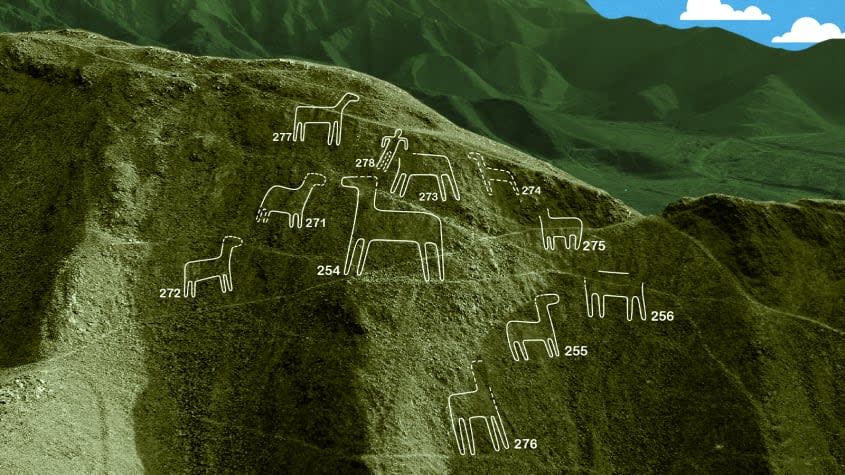Peru's mysterious Nazca Lines

They've been around for thousands of years, but little is definitively known about Peru's mysterious Nazca Lines, in which scientists recently discovered more than 100 new designs. Here's what researchers understand so far:
What are the Nazca Lines?
The Nazca Lines are enormous geoglyphs located in the Peruvian desert southeast of Lima. Massive, white strips that depict pictures and geometric designs, the lines were long ago carved into the ground of the Rio Grande de Nasca river basin, one of the driest places on the planet. The lack of rainfall and wind in the area has helped the glyphs maintain their shape over the years.
The etchings are believed to have been created by the Nazca people who lived between 1 and 700 A.D., per National Geographic. Along with carvings that depict animals, some of the drawings also depict humanoid and hybrid figures and potential scenes from everyday life. For example, an etch discovered in 2011 appears to show a decapitation, which is in keeping with the belief that the Nazca people collected "trophy heads," per History.
The Nazca Lines and their surrounding area have been deemed a World Heritage Site by the United Nations. The best way to view the lines is from above in a helicopter or plane; in fact, many were unaware the over 2000-year-old lines even existed until the invention of flight.
Why were the lines created?
The meaning of the lines has long been studied and debated.
After observing them from both the ground and the air, American historian Paul Kosok posited in the 1930s and 40s that the glyphs were created for astronomical purposes. German archaeologist María Reiche proposed similarly shortly thereafter, noting that the lines may have also served as a calendar.
Reiche and Kosok's were long the accepted theories until a surge of research in the 1960s and 70s brought about new ideas. Johan Reinhard, a National Geographic Explorer-in-Residence, examined the region surrounding the lines and concluded that most of them "did not point at anything on the geographical or celestial horizon," he wrote in his book, The Nasca Lines: A New Perspective on their Origin and Meanings. Rather, the lines "led to places where rituals were performed to obtain water and fertility of crops." The animal drawings in particular support this theory, other scholars have said, considering some of the creatures depicted are historic symbols of rain, water, and fertility, per History.
"No single evaluation proves a theory about the lines, but the combination of archeology, ethnohistory, and anthropology builds a solid case," Reinhard continued in The Nasca Lines.
Any other theories?
As new research about the lines emerged, so did outlandish theories about their origin — including one that claimed they were actually created by aliens.
Erich von Däniken, a Swiss amateur archaeologist, once claimed that the trapezoidal drawings as well as some of the humanoid drawings represented an alien landing point and an alien. He believed the lines were created a long time ago when aliens visited Earth. His theory has since been debunked as a conspiracy.
But the belief nonetheless gained prominence, in large part due to doubts humans could create glyphs that large; that the lines must be viewed from the air only added fuel to that fire. However, some have decried the claim as bigoted, since archaeologists have suggested that the Nazca people were actually quite technologically advanced.
Still, no one knows for sure the exact purpose of the lines — and any understanding we have will surely change over time. "There's no doubt that the world's understanding of the Nasca lines will continue to evolve," Reinhard concluded in his book.
Have the lines ever been threatened?
Preservation has, at times, proved difficult. In 2009, the area around the lines faced record rain damage, leading to clay deposits in one of the most famous glyphs. In 2014, the organization Greenpeace purposely destroyed the area around one of the lines to promote renewable energy. And most recently, economic developments in Peru have threatened the conservation of the land.
What did scientists recently discover?
Scientists just discovered over 100 new lines after analyzing new field surveys and drone footage. The research was conducted by archaeologists from Yamagata University in Japan. The newly-discovered lines are smaller than the others and can actually be seen on the ground, Reuters reports.
Interested in seeing all of this up close? Tourists can take aerial tours of the Nazca Lines to view the mysterious etchings for themselves.
You may also like
The rise of the world's first trillionaire

